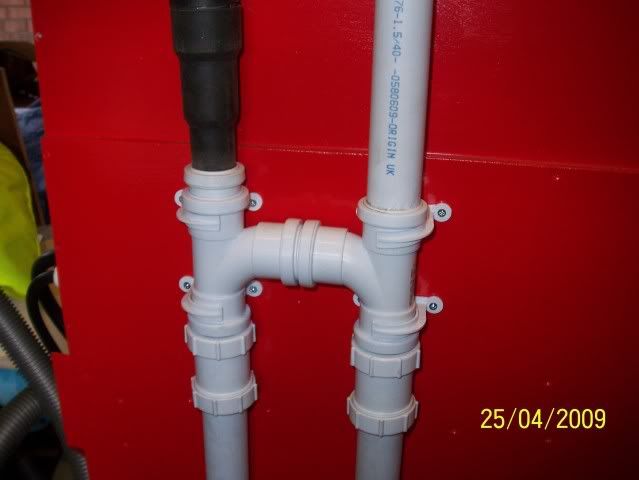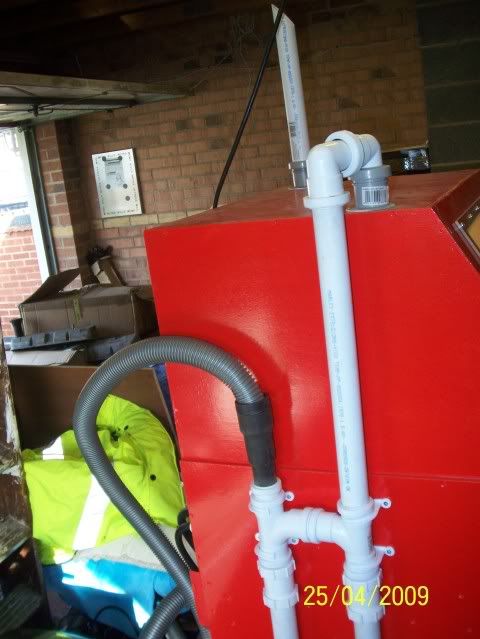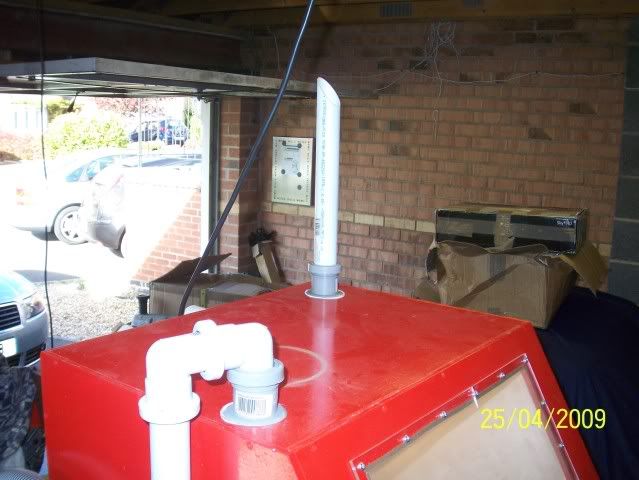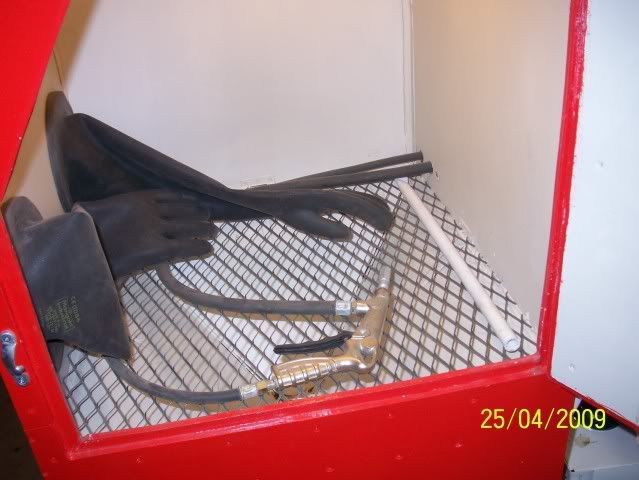Home blast cabinets
Discussion
I'm looking at getting a cheap and cheerful blast cabinet from the likes of machine mart etc. for use with cleaning mainly aluminium components on a few home engine builds. The ones we use at work are decent industrial ones fed from big industrial compressors so I have never had to consider air supply and feeds.
Has anyone run said DIY blast cabinets from your average home compressor, say 8 bar circa 40 litre tank? Are they powerful enough to make the blaster work effectively?
Has anyone run said DIY blast cabinets from your average home compressor, say 8 bar circa 40 litre tank? Are they powerful enough to make the blaster work effectively?
I built a home blast cabinet from the kit supplied by frost.
http://www.frost.co.uk/diy-blast-cabinet-kit.html
I have a 14cfm compressor which copes fine but previously had a 6.3cfm which was hopeless, you'd get 30 seconds of blast then have to wait a couple of minutes for it to fill the air tank again.
The Frost kit is quite hard work but does make a bloody good blast cabinet. I made a few minor mods and component upgrades I've got a pic or two that I will try and post up later.
Also my neighbour has a metal clarke cabinet - he has loads of bother with it clogging up due to condensation - I have no bother at all as the kit is built from plywood.
http://www.frost.co.uk/diy-blast-cabinet-kit.html
I have a 14cfm compressor which copes fine but previously had a 6.3cfm which was hopeless, you'd get 30 seconds of blast then have to wait a couple of minutes for it to fill the air tank again.
The Frost kit is quite hard work but does make a bloody good blast cabinet. I made a few minor mods and component upgrades I've got a pic or two that I will try and post up later.
Also my neighbour has a metal clarke cabinet - he has loads of bother with it clogging up due to condensation - I have no bother at all as the kit is built from plywood.
Edited by Barkychoc on Saturday 12th January 08:51
For what it is worth I have a Clarke cabinet with both glass bead and grit media. I run it with a big compressor but my biggest gripe is that after a while so much dust is raised inside the cabinet that you can no longer see the work piece - and attaching a vacuum cleaner to the outlet only improves matters a little (although the likelihood is that your vacuum will self destruct in due course if fed on a diet of very fine gritty particles).
I would also advise ALWAYS to wear eye protection and ALWAYS wear a proper dust mask to something like P2, P3 standard.
I would also advise ALWAYS to wear eye protection and ALWAYS wear a proper dust mask to something like P2, P3 standard.
A big compressor and tank is best... but it can work with an 8CFM compressor and a big tank, you just have to wait for the air to build. I know a few people who use a large calor gas bottle as a tank, in fact my mate has two sitting outside his garage, just linked into his air supply! The SWP on these is a lot higher than a standard compressor puts out.
One thing to consider is no matter how good they are sealed, a cabinet will always leak media unless you have a free flowing vent out of it, to the outside.
This is my setup. you will see there is a large diameter pipe from the cabinet going into a plastic box underneath, and then vented outside. inside the box is a set of baffles which make the air turn several times before exiting the pipe to the outside of the garage. Its the principle used by dyson, as the air is forced to turn, any partials are flung to the outside as they are heavier, and drop to the bottom of the box.
I did wonder how effective it would be, but it works just fantastic! there is never any dust in the workshop (important as I have a lathe and milling machine in there...)and there is practically no media outside the garage from the pipe. Some media does collect in the box, but I just recycle that back into the cabinet!

One thing to consider is no matter how good they are sealed, a cabinet will always leak media unless you have a free flowing vent out of it, to the outside.
This is my setup. you will see there is a large diameter pipe from the cabinet going into a plastic box underneath, and then vented outside. inside the box is a set of baffles which make the air turn several times before exiting the pipe to the outside of the garage. Its the principle used by dyson, as the air is forced to turn, any partials are flung to the outside as they are heavier, and drop to the bottom of the box.
I did wonder how effective it would be, but it works just fantastic! there is never any dust in the workshop (important as I have a lathe and milling machine in there...)and there is practically no media outside the garage from the pipe. Some media does collect in the box, but I just recycle that back into the cabinet!

DrDeAtH said:
Got any internal pics of the catch box?
Here you go, its simple. As the air comes in you make it turn to go around the baffles. As the air turns, the heavy partials are thrown to the outside and fall to the bottom. When you empty it, there is more in the first compartment and less in the last. In fact, I cant ever remember there being anything in the last one, there is certainly no grit on the outside of the garage on the floor, even after hours of use!As this method of filtration does not form any sort of resistance to the air, the cabinet is not pressurised in any way so it tends to stay relatively clear in there. Commercial filtration systems work like this, and some old types of car air cleaners where there was a bath of oil in the bottom to catch the dirt. They were a very effective filter, but by their nature tended to be big and bulky so they fell out of fashion.

I said ages ago I would post pictures above.
Here's my home made cabinet from the Frost kit.
It pulls air from the top of the cabinet for extraction.
Lots of people said it wouldn't work and be too dusty but its fine, although it might be better to move the pipe connection to the rear.
The black / silver pipe is the vacuum cleaner hose (now using a Henry at low speed) and the right hand pipe going up is to the top of the cabinet.
Both pipes going down are a dead end - so the sudden direction change in the pipework causes any particles to drop to the bottom of the tube.
These are emptied periodically into a bin. The only thing collected is very fine particles like flour, tipping it back in the cabinet is a no no its far too fine - you can't see a bloody thing.
The first pipe drop from the cabinet collects a bit of grit - the second collects hardly anything.
There is an inlet to the top of the cabinet on the opposite side (see the 'chimney')- so air is drawn through the cabinet at low pressure.






Here's my home made cabinet from the Frost kit.
It pulls air from the top of the cabinet for extraction.
Lots of people said it wouldn't work and be too dusty but its fine, although it might be better to move the pipe connection to the rear.
The black / silver pipe is the vacuum cleaner hose (now using a Henry at low speed) and the right hand pipe going up is to the top of the cabinet.
Both pipes going down are a dead end - so the sudden direction change in the pipework causes any particles to drop to the bottom of the tube.
These are emptied periodically into a bin. The only thing collected is very fine particles like flour, tipping it back in the cabinet is a no no its far too fine - you can't see a bloody thing.
The first pipe drop from the cabinet collects a bit of grit - the second collects hardly anything.
There is an inlet to the top of the cabinet on the opposite side (see the 'chimney')- so air is drawn through the cabinet at low pressure.






Edited by Barkychoc on Wednesday 1st January 21:08
Gassing Station | Home Mechanics | Top of Page | What's New | My Stuff



